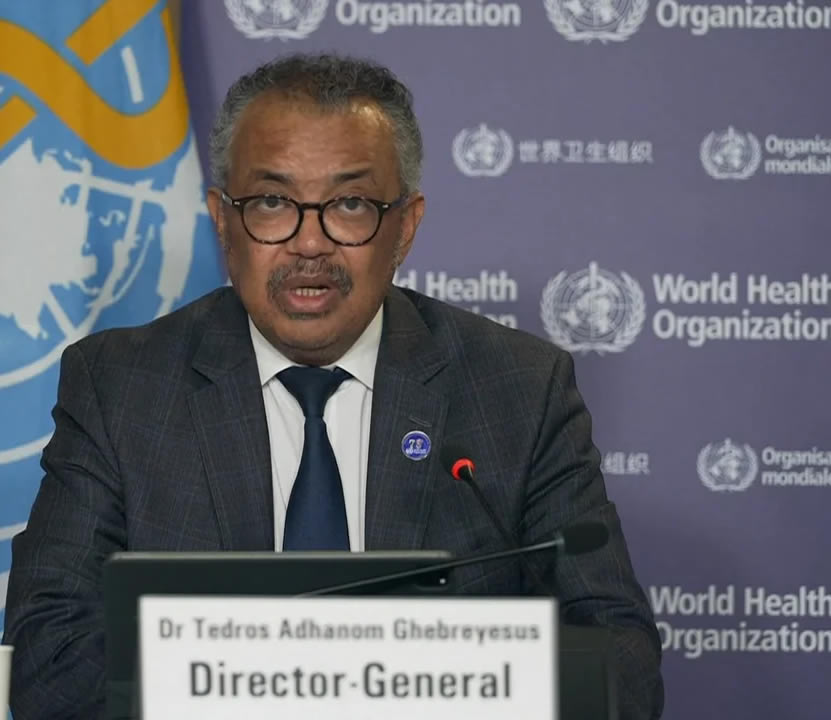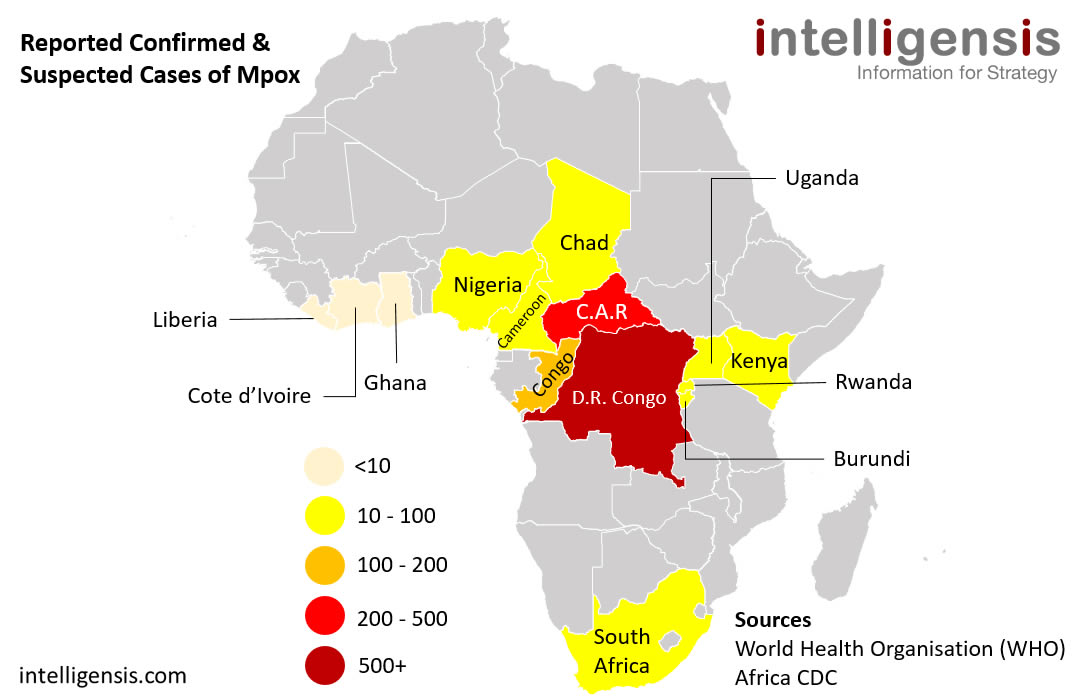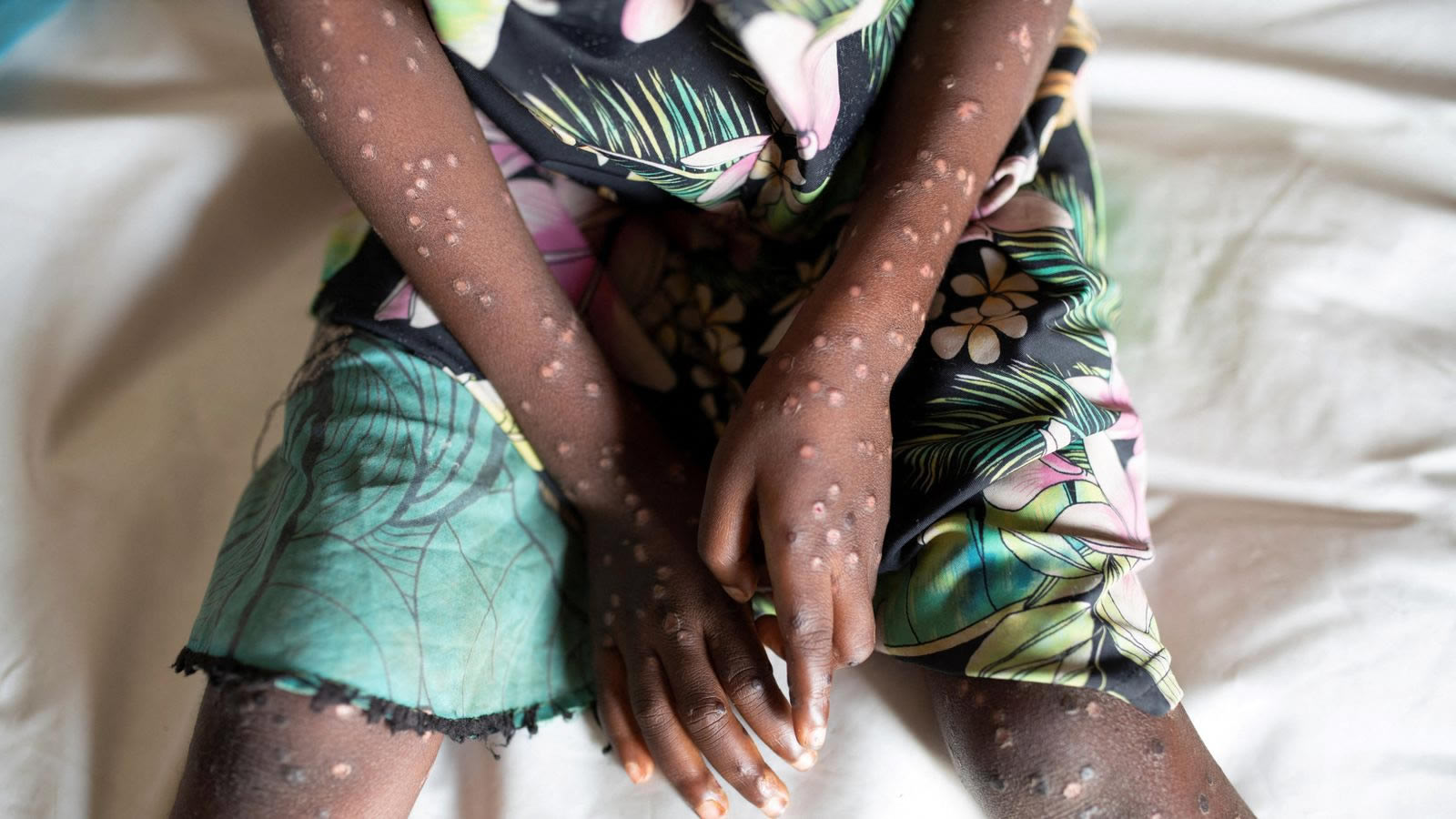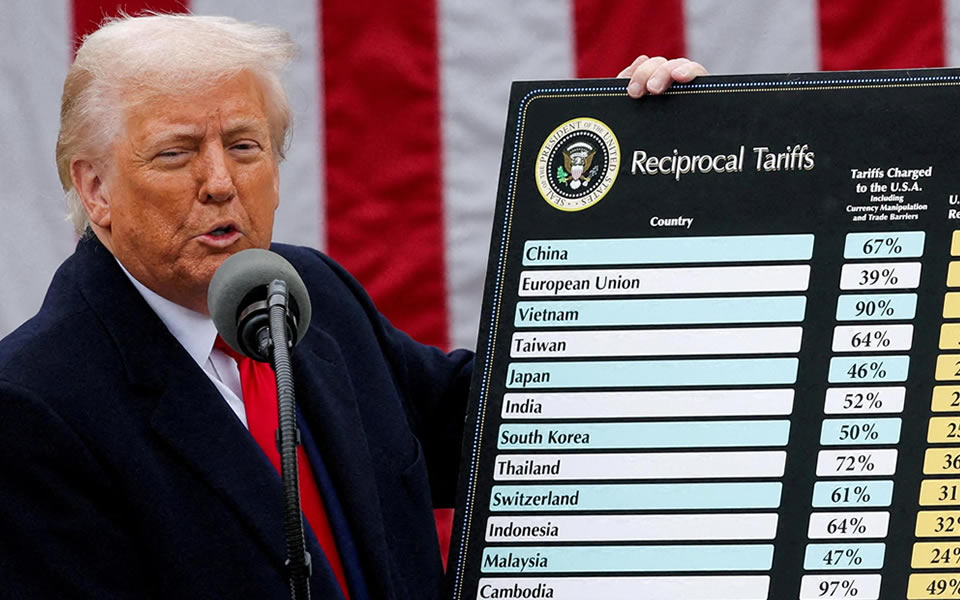
Interactive Dashboard: JNIM’s political violence
June 25, 2024
Ghana Decides 2024: Comparing NPP & NDC Policy Visions
September 10, 2024MPOX OUTBREAK: CURRENT SITUATION & FORECAST
What You Should Know
- The Mpox outbreak in East Africa and other parts of the continent has led to the declaration of a Public Health Emergency of International Concern (PHEIC) by the Africa CDC and WHO.
- The outbreak originated in the Democratic Republic of Congo (DRC) and has spread to neighboring countries, with over 17,000 suspected cases and 500 deaths reported in 2024.
- The Clade I variant, known for its higher severity, is the main strain driving the outbreak, particularly affecting children and individuals with compromised immune systems.
- Global and regional health bodies are intensifying efforts to control the outbreak through vaccination, enhanced surveillance, and support to affected regions.
- The ongoing spread of Mpox poses a significant threat to public health in Africa and potentially beyond, requiring coordinated international action to prevent further transmission.

WHO Director-General Dr Tedros Adhanom Ghebreyesus has determined that the upsurge of mpox in the Democratic Republic of the Congo (DRC) and a growing number of countries in Africa constitutes a public health emergency of international concern (PHEIC) under the International Health Regulations (2005) (IHR).
Situation Overview

The Mpox outbreak in East Africa and other parts of the continent has become a serious public health challenge, prompting the Africa CDC and the WHO to declare it a Public Health Emergency of International Concern (PHEIC). This outbreak, which originated in the Democratic Republic of Congo (DRC), has rapidly spread to neighboring countries, including Burundi, Kenya, Rwanda, and Uganda. The situation is particularly concerning due to the emergence of a new variant, Clade Ib, which appears to transmit more easily and has resulted in a significant rise in cases, especially among children and individuals with compromised immune systems.
Reports indicate that over 17,000 suspected cases and more than 500 deaths have been documented across 13 African countries in 2024 alone. The virus's spread has been facilitated by close human contact, and the lack of sufficient healthcare resources has further exacerbated the situation. In response, global and regional health bodies are intensifying efforts to control the outbreak, including deploying vaccines, enhancing surveillance, and providing support to affected regions.
Despite these efforts, the outbreak continues to pose a significant threat to public health in the region and potentially beyond. The situation demands coordinated action, with a focus on improving access to medical care, vaccines, and public health education to prevent further transmission and mitigate the impact of the disease.

Mpox Patient in Democratic Republic of Congo (DRC). Picture by Reuters
About the Mpox Disease
Mpox (formerly called Monkeypox) is a viral disease caused by the monkeypox virus, which belongs to the same family as the smallpox virus. The disease can be transmitted through close contact with an infected person, including physical contact with skin lesions, respiratory droplets, or contaminated materials like bedding. Mpox can also spread from animals to humans, typically through direct contact with infected wildlife such as rodents and primates.
Symptoms of Mpox usually begin with fever, headache, muscle aches, and swollen lymph nodes, followed by a rash that often starts on the face and spreads to other parts of the body. The rash progresses from flat lesions to fluid-filled blisters, which eventually crust over and fall off. The illness typically lasts for two to four weeks, and while many cases are mild, the disease can lead to severe complications, especially in young children, pregnant women, and individuals with weakened immune systems.
The severity of the disease varies depending on the viral strain. The Clade I variant, currently spreading in Central and Eastern Africa, is known for causing more severe illness, with higher fatality rates compared to the Clade II variant that circulated globally in 2022. Vaccination and early medical intervention are crucial in managing the spread and impact of the disease, particularly in high-risk populations. Public health measures, including isolation of infected individuals and contact tracing, are also essential to contain outbreaks.
Timeline of Mpox Disease Outbreak
The following timeline of the Mpox outbreak provides a historical overview of the disease's progression from its initial discovery to its current status as a global public health concern.
1958 - Discovery of Mpox
Mpox was first identified in 1958 when two outbreaks of a pox-like disease occurred in colonies of monkeys kept for research, leading to the name "monkeypox."1980s-1990s - Sporadic Cases
During this period, sporadic cases of Mpox were reported primarily in rural, rainforest regions of Central and West Africa, particularly in the DRC.2003 - First U.S. Outbreak
The first outbreak of Mpox outside Africa occurred in the United States in 2003, linked to imported animals, leading to over 70 reported cases.2017 - Re-Emergence in Nigeria
A significant outbreak of Mpox occurred in Nigeria in 2017 after nearly 40 years without reported cases, marking the re-emergence of the virus in West Africa.2022 - Global Outbreak
In 2022, Mpox cases were reported in multiple non-endemic countries around the world, including Europe and the Americas, marking the largest outbreak of the disease outside Africa.May 2022 - WHO Declaration
The World Health Organization (WHO) declared the multi-country Mpox outbreak a Public Health Emergency of International Concern (PHEIC) in May 2022.January 2024 - WHO Update on Global Spread
WHO reported a slight resurgence of Mpox cases, particularly in Europe and North America, with notable clusters emerging due to vaccine hesitancy and declining immunity in certain populations.March 2024 - New Vaccine Rollout
A new generation of Mpox vaccines was launched worldwide, with targeted campaigns to enhance coverage among high-risk groups in regions experiencing the resurgence, including parts of Europe, North America, and Africa.May 2024 - Updated WHO Guidelines
WHO released revised guidelines for Mpox management, emphasizing rapid testing, stricter isolation protocols, and updated treatment options, aimed at controlling the virus's spread in both urban and rural areas.July 2024 - Mpox in Humanitarian Settings
The virus was reported in conflict zones and refugee camps, particularly in regions of Africa and the Middle East, leading international health agencies to intensify efforts to contain the spread in these high-risk, underserved environments.August 2024 - Declaration of Current Outbreak & Continued Surveillance
On August 3, 2024, the World Health Organization (WHO) and the Africa CDC officially declared a new Mpox outbreak in several regions of Africa and parts of Europe, prompting a renewed focus on global surveillance efforts. The declaration emphasized the urgent need to prevent the spread to previously unaffected areas and to ensure that vaccines and treatments are accessible, especially in regions with fragile healthcare systems.
Affected Countries & Regions
Democratic Republic of Congo (DRC)
The Democratic Republic of Congo (DRC) remains the central focus of the Mpox outbreak, reporting the majority of cases and deaths. Since January 2023, the DRC has recorded over 22,000 suspected cases and more than 1,200 deaths. The outbreak in the DRC involves Clade I of the virus, which is associated with a higher rate of severe illness and fatalities. The situation is particularly dire in rural areas, where healthcare access is limited, and surveillance efforts are challenged by the vast geography and ongoing conflict.
East Africa: Burundi, Kenya, Rwanda and Uganda
Mpox has recently spread to East Africa, with Burundi, Kenya, Rwanda, and Uganda all reporting their first confirmed cases of Clade I Mpox in 2024. These countries have seen a rapid increase in cases linked to the ongoing outbreak in the DRC. In Burundi, 61 cases have been confirmed, primarily among adults. Kenya reported its first case in a long-distance truck driver, indicating potential cross-border transmission. Rwanda and Uganda have also confirmed cases, with Rwanda identifying its first cases at points of entry and healthcare facilities. The spread to these countries marks a significant geographic expansion of the outbreak.
Central Africa: Central African Republic (CAR) and Republic of Congo (ROC)
The Central African Republic (CAR) and Republic of Congo (ROC) have both confirmed outbreaks of Clade I Mpox in 2024, with cases linked to the ongoing outbreak in the DRC. CAR has reported 28 cases, primarily in the capital, Bangui, while ROC declared an outbreak in April 2024. These countries are experiencing challenges similar to those in the DRC, with limited resources to manage the outbreak effectively.
West Africa: Côte d’Ivoire
Côte d’Ivoire has reported a re-emergence of Mpox in 2024, with six confirmed cases linked to Clade II of the virus. This marks the first time the country has reported cases since the global outbreak began in 2022. The cases have been identified in several districts, including Tabou, Koumassi, and Yopougon, indicating a spread beyond the initial point of detection.
Southern Africa: South Africa
South Africa has also reported cases of Mpox in 2024, with 24 confirmed cases across several provinces. The recent cases include a traveler from Peru, raising concerns about international spread. South Africa's outbreak involves Clade II of the virus, and while most cases have recovered, the situation remains concerning due to the potential for further transmission.
Global Context
Mpox cases have also been reported outside Africa, with countries in the Americas, Europe, and Asia continuing to monitor and manage cases linked to the Clade II variant. While the global situation has stabilized compared to 2022, the ongoing outbreak in Africa, particularly the spread of Clade I, poses a significant risk of international transmission.
Forecast
The Mpox outbreak across parts of Africa, particularly the spread of the Clade I virus, is expected to continue presenting significant challenges in the coming months. With the outbreak already spreading to multiple countries, the potential for further geographic expansion remains high, especially in regions with porous borders and limited healthcare infrastructure.
Continued Spread in East & Central Africa
The Democratic Republic of Congo (DRC) will likely remain the epicenter of the outbreak, with high case numbers expected to persist due to ongoing transmission within the country and across its borders. Neighboring countries like Burundi, Kenya, Rwanda, and Uganda, which have recently reported their first cases, are at risk of seeing increased transmission. The interconnectedness of these regions, combined with challenges in surveillance and healthcare access, suggests that the outbreak could extend further into East Africa.
Potential for Cross-Border Transmission
As seen in the spread to countries like Kenya and Uganda, cross-border transmission is a significant concern. The movement of people across borders, especially in conflict-affected areas and through trade routes, could facilitate the spread of Mpox to additional countries within the region. This could lead to new outbreaks in previously unaffected areas, further complicating containment efforts.
Risk of Global Transmission
While Clade I Mpox has primarily remained within Central and East Africa, there is a continued risk of international spread, particularly through travel and trade. Countries outside Africa that have already experienced outbreaks of Clade II Mpox may need to remain vigilant for potential importation of Clade I cases. The global health community should be prepared for isolated cases appearing in other regions, which could require rapid response measures to prevent wider outbreaks.
Impact on Vulnerable Populations
Children, pregnant women, and individuals with compromised immune systems, particularly those living with HIV, will continue to be at heightened risk for severe outcomes if exposed to the virus. The ongoing challenges in vaccine distribution and healthcare access in affected regions suggest that these vulnerable groups may experience disproportionately higher morbidity and mortality rates.
Urgency of Global Response
Given the scale and severity of the outbreak, international support will be critical in the coming months. Efforts to increase vaccine distribution, enhance surveillance, and strengthen healthcare systems in the affected regions will be essential to controlling the outbreak. Without significant intervention, the Mpox outbreak has the potential to escalate further, with broader implications for public health both within Africa and globally.



